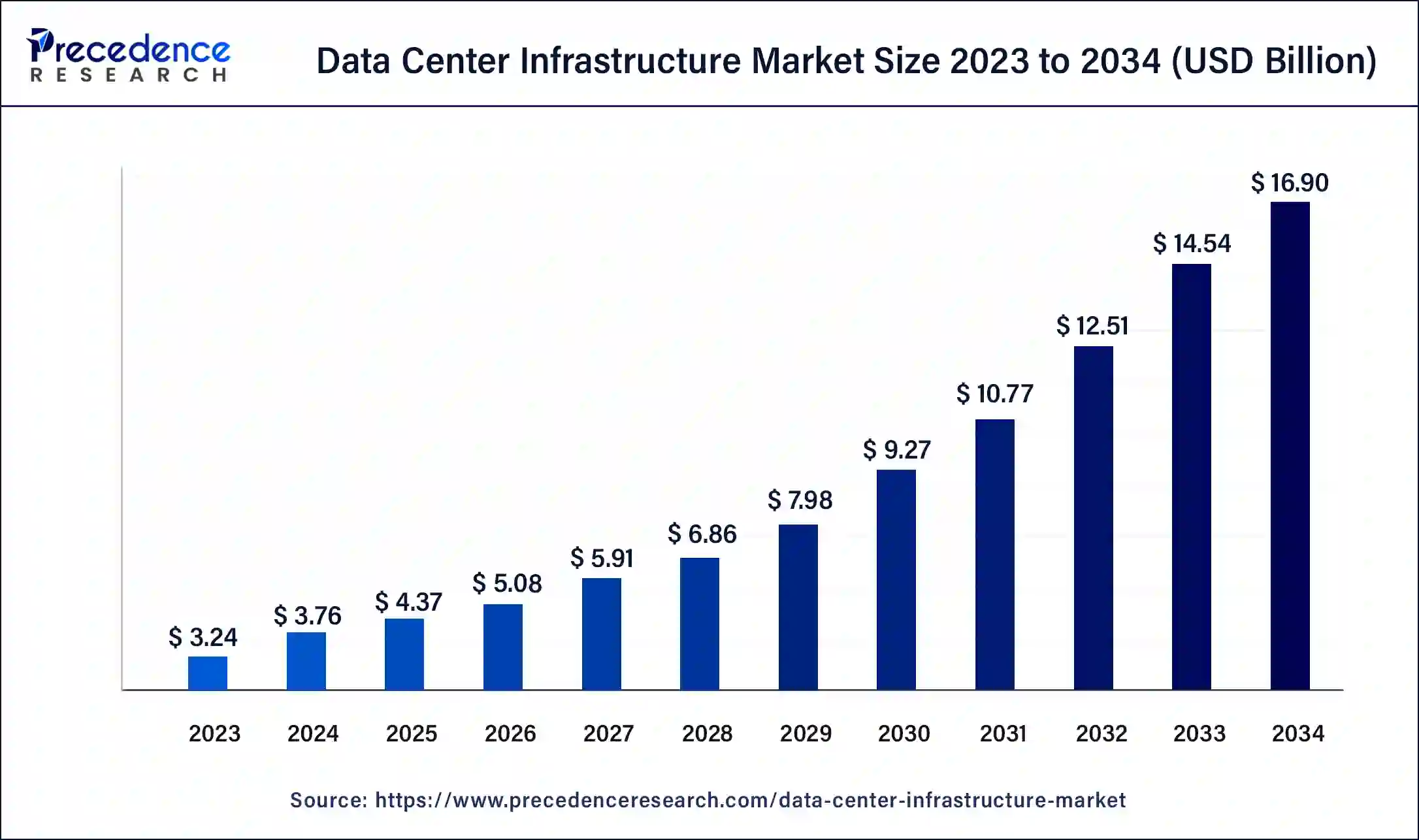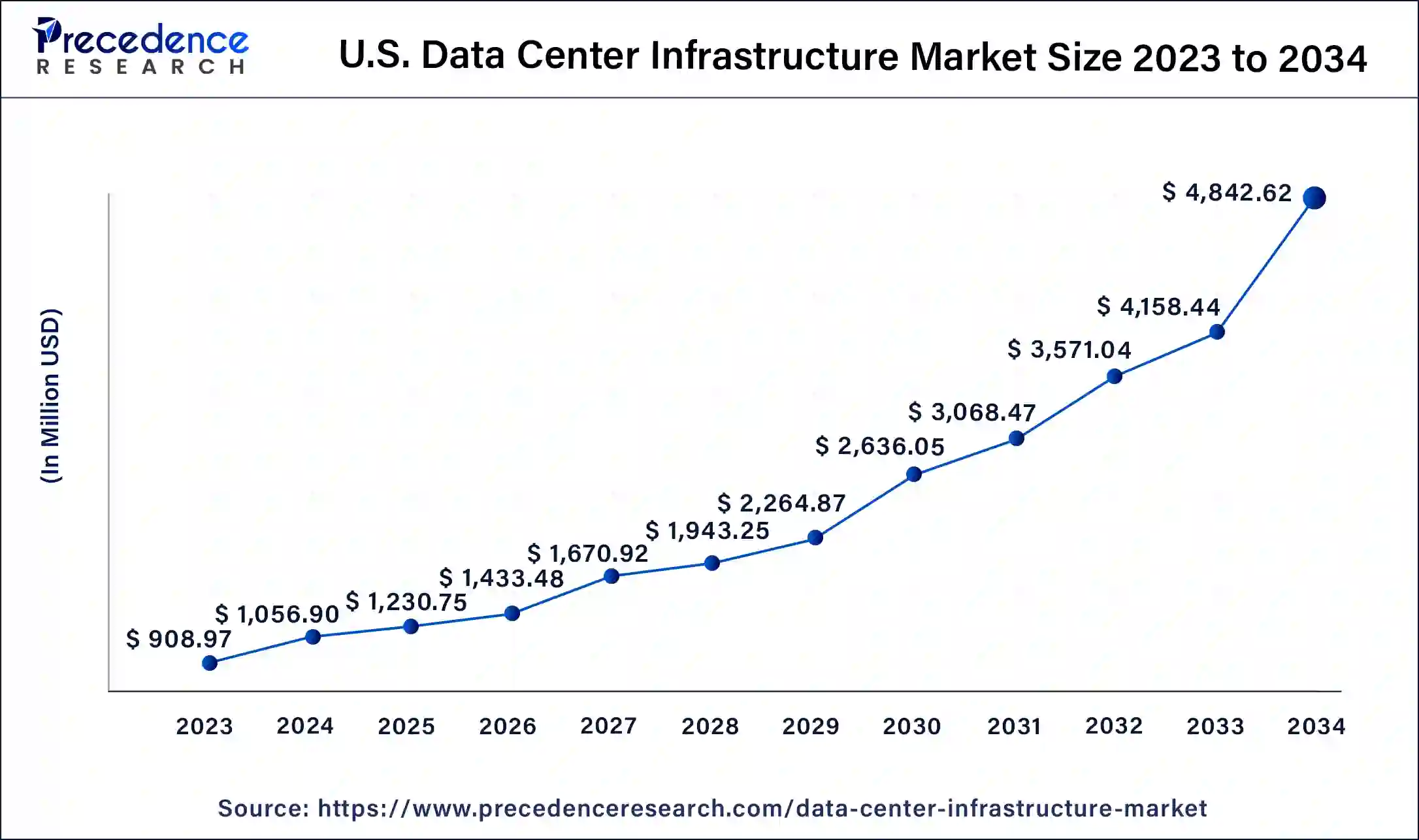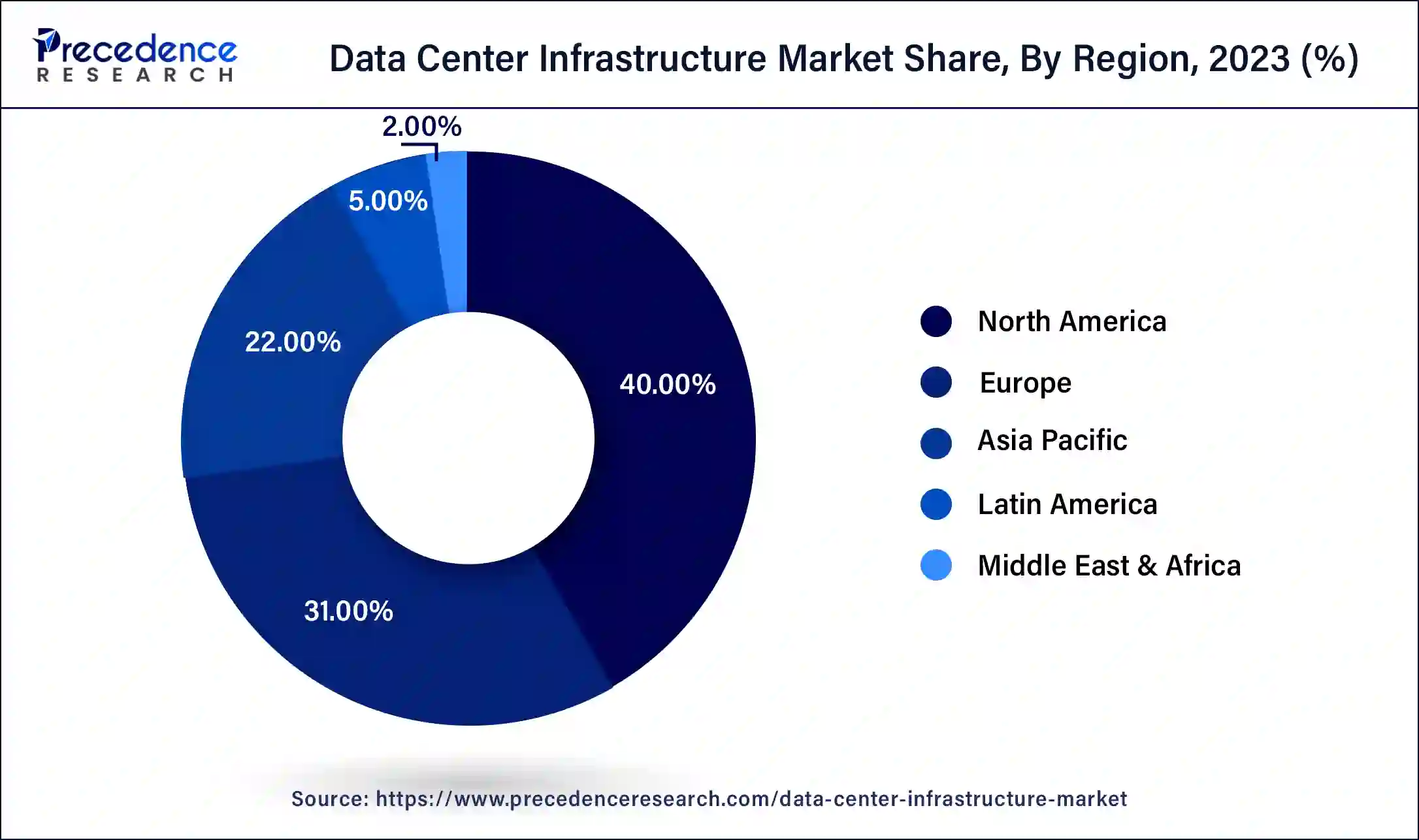Data Center Infrastructure Market Size and Forecast 2025 to 2034
The global data center infrastructure market size was estimated at USD 3.76 billion in 2024 and is predicted to increase from USD 4.37 billion in 2025 to approximately USD 16.90 billion by 2034, expanding at a CAGR of 16.20% from 2025 to 2034.

Data Center Infrastructure Market Key Takeaways
- North America contributed more than 40% of revenue share in 2024.
- Asia Pacific is estimated to expand the fastest CAGR between 2025 and 2034.
- By component, the solution segment has held the largest market share of 78% in 2024.
- By component, the service segment is anticipated to grow at a remarkable CAGR of 18.5% between 2025 and 2034.
- By data center type, the enterprise data center segment generated over 38% of revenue share in 2024.
- By data center type, the cloud and edge data center segment is expected to expand at the fastest CAGR over the projected period.
- By application, the asset management segment had the largest market share of 43% in 2024.
- By application, the BI and analytics segment is expected to expand at the fastest CAGR over the projected period.
- By enterprise size, the large-sized enterprises segment had the largest market share of 69% in 2024.
- By enterprise size, the small and medium-sized enterprises segment is expected to expand at the fastest CAGR over the projected period.
- By end user, the IT sector segment had the largest market share of 37% in 2024.
- By end user, the healthcare and life science segment is expected to expand at the fastest CAGR over the projected period.
U.S. Data Center Infrastructure Market Size and Growth 2025 to 2034
The U.S. data center infrastructure market size was calculated at USD 1,056.90 million in 2024 and is projected to be worth around USD 4,842.62 million by 2034, poised to grow at a CAGR of 16.40% from 2025 to 2034..

North America has held the largest revenue share of 40% in 2024. In North America, the data center infrastructure market is characterized by a strong emphasis on innovation and sustainability. The region is witnessing a growing trend in green data centers, focusing on renewable energy sources, energy-efficient cooling systems, and environmentally responsible practices. There's a substantial movement towards edge computing to reduce latency for real-time applications, such as IoT and 5G.

Asia-Pacific is estimated to observe the fastest expansion. The Asia-Pacific region is marked by rapid growth and increasing investment in data center infrastructure. This region is embracing 5G technology, driving the need for advanced infrastructure to support the network. Asia-Pacific is witnessing a growing focus on cost-effective solutions to cater to its diverse and expanding markets. In addition, there is a pronounced interest in modular and prefabricated data centers to meet the demand for scalability and rapid deployment.
Market Overview
The data center infrastructure market encompasses the worldwide sector responsible for providing the essential physical components and technology required for the functioning of data centers. These components comprise servers, storage devices, networking equipment, power and cooling systems, and security solutions.
As the demand for digital services and data storage continues to surge, this market has witnessed substantial expansion. It encompasses various players, from hardware manufacturers to software providers and service companies, all contributing to the development and maintenance of data center facilities. The market continues to evolve to meet the expanding needs of businesses for reliable and efficient data processing and storage solutions.
- According to the AFCOM's 2025 State of the Data Center Report, the data center industry shift is underway, with 80% of respondents anticipating major increases in capacity needs due to AI workloads and 64% already deploying AI-capable solutions, which showcases the rapid and widespread adoption of AI in data centers.
- In March 2025, Chhattisgarh Chief Minister Vishnu Deo Sai laid the foundation stone for the country's first Artificial Intelligence Data Center Park in Sector-22 of Nava Raipur, in a defining moment for India's digital infrastructure roadmap. This data center is spread across 13.5 acres. This pioneering project is being developed by RackBank Datacenters Private Limited and is fully dedicated to AI-based services.
Data Center Infrastructure Market Growth Factors
- The relentless wave of digital transformation initiatives across industries drives the need for state-of-the-art data center infrastructure.
- The proliferation of cloud services continues to escalate, thereby intensifying the demand for advanced data center solutions.
- The explosive growth in IoT devices and the generation of vast data sets necessitate cutting-edge infrastructure to manage and process this data efficiently and securely.
- A pivotal trend is the shifting of data centers closer to end-users, reducing latency and enhancing performance, as applications demand real-time processing.
- Embracing sustainable practices, data centers increasingly integrate renewable energy sources to reduce their environmental footprint.
- The growing demand for edge computing necessitates the creation of infrastructure that can cater to decentralized, distributed data processing, and storage requirements, opening new horizons for infrastructure providers.
- The significant shift towards remote and hybrid work models has amplified the need for data center infrastructure supporting remote connectivity, collaboration, and data access.
Market Scope
| Report Coverage | Details |
| Growth Rate from 2025 to 2034 | CAGR of 16.2% |
| Market Size in 2024 | USD 3.76 Billion |
| Market Size in 2025 | USD 4.37 billion |
| Market Size by 2034 | USD 16.90 Billion |
| Largest Market | North America |
| Base Year | 2024 |
| Forecast Period | 2025 to 2034 |
| Segments Covered | By Component, By Data Center Type, By Application, By Enterprise Size, and By End User |
| Regions Covered | North America, Europe, Asia-Pacific, Latin America, and Middle East & Africa |
Market Dynamics
Driver
Digital transformation and cloud computing
The rise of cloud computing, offering flexible, on-demand access to computing resources, has instigated a fundamental transformation in how data is stored and processed. Cloud service providers are driving substantial demand for data center infrastructure to support the expanding array of virtual machines, storage capacities, and networking resources they provide to businesses. This demand has prompted data center operators to undertake extensive expansions and upgrades to their facilities, in turn, propelling the market's growth in response to the burgeoning need for cloud services.
IoT and big data, on the other hand, have brought about an explosion of connected devices and data generation. IoT devices continuously collect and transmit data, while big data analytics necessitate significant computing power to derive valuable insights.
As businesses harness these technologies to gain a competitive edge, data center infrastructure is essential to store and process this data efficiently, further escalating the demand for data centers equipped with the latest hardware, advanced networking, and robust security features. Together, cloud computing, IoT, and big data have transformed the data center landscape, making it a critical and expanding sector in today's digital economy.
Restraint
High energy consumption and complex cooling requirements
High energy consumption and complex cooling requirements are significant restraints for the demand for the data center infrastructure market. Data centers are known for their substantial energy demands, and as they expand in size and capabilities, their need for electricity increases. This results in not only significant operational expenses but also environmental apprehensions related to the carbon emissions linked to power generation.
The imperative to curtail energy consumption and meet sustainability targets is compelling data center operators to invest in energy-efficient infrastructure, a process that can be both expensive and time-intensive to establish.
Additionally, the complex cooling requirements in data centers are a critical challenge. To maintain the optimal operating temperature for servers and equipment, intricate cooling systems are essential. These systems can be expensive to install and maintain, and they often consume a significant portion of the overall energy usage in a data center. The intricate network of cooling infrastructure also adds to the complexity of data center management, requiring specialized expertise and resources. As such, these challenges pose hurdles in terms of cost, energy efficiency, and operational complexity, restraining the market demand for data center infrastructure.
Opportunity
AI, automation and edge computing expansion
The data center infrastructure market is experiencing a substantial surge in demand driven by the rapid expansion of AI, Automation, and edge computing. AI applications demand extensive computing power for tasks like machine learning and data analytics. As AI becomes increasingly integrated into various industries, data centers must be equipped with the latest hardware to meet computational requirements. This is propelling the need for high-performance servers, advanced networking equipment, and efficient cooling solutions, thus driving market growth.
Automation, another transformative technology, relies on data center infrastructure for seamless operations. Data centers underpin the remote management and orchestration of resources, enhancing operational efficiency. Furthermore, as businesses automate their processes, the need for reliable data storage and backup solutions grows, further stimulating demand.
Edge computing, which involves processing data closer to its source, demands decentralized data center infrastructure. Data centers at the edge need to be compact, energy-efficient, and highly responsive to deliver real-time processing capabilities. This trend is pushing data center providers to develop innovative solutions tailored to edge computing requirements, creating new opportunities for growth in the market. In essence, AI, Automation, and edge computing are at the forefront of reshaping data center infrastructure, catalyzing demand for more advanced, scalable, and efficient solutions.
Component Insights
According to the component, the disposables segment has held 78% revenue share in 2024. Solutions in the market encompass the physical and virtual components required for data center operation. This includes servers, storage systems, networking equipment, power and cooling solutions, and security systems. Software-defined data centers (SDDC) are also gaining prominence, enabling greater agility and automation through virtualization and centralized management.
The service segment is anticipated to expand at a significantly CAGR of 18.5% during the projected period. Services represent the range of support offerings, including installation, maintenance, consulting, and managed services. The trend in services is towards increased automation and remote management, as well as a growing emphasis on security and energy efficiency services, aligning with the evolving needs of data center operators.
Data Center Type Insights
Based on the data center type, the enterprise data centers segment held the largest market share of 38% in2024. Enterprise data centers are privately owned facilities dedicated to an organization's data processing and storage needs. These data centers are typically on-premises and serve as the core IT infrastructure for a single business. A key trend in this space is the move towards more energy-efficient and sustainable operations, with enterprises increasingly adopting green technologies and practices to reduce environmental impact while enhancing cost-efficiency and reliability.
On the other hand, the cloud and edge data centers segment is projected to grow at the fastest rate over the projected period. Cloud and edge data centers are part of the broader trend towards decentralized computing. Cloud data centers, hosted by service providers, offer scalable resources for businesses, while edge data centers are located closer to end-users for low-latency processing. In the market, the trend is toward optimizing these data centers for rapid data processing, often integrating renewable energy sources, and enhancing security to support the growth of cloud services and edge computing applications.
Application Insights
In2024, the asset management segment had the highest market share of 43% based on the application. In the data center infrastructure market, asset management refers to the systematic monitoring, tracking, and optimization of physical components such as servers, storage devices, and networking equipment. This helps in maximizing their lifespan and efficiency. A key trend is the adoption of AI-driven asset management, allowing predictive maintenance, reducing downtime, and optimizing resource allocation. Asset management solutions are increasingly integrated with data center infrastructure to ensure optimal use of assets, reducing operational costs, and enhancing reliability.
The BI and analytics segment is anticipated to expand at the fastest rate over the projected period. Business Intelligence (BI) and analytics in data centers involve processing and analyzing large volumes of data for insights and decision-making. The trend is toward integrating advanced analytics capabilities directly within data center infrastructure to support real-time data processing and reporting. This ensures that businesses can extract valuable insights faster and more efficiently, enabling data-driven decision-making and enhancing overall operational efficiency and competitiveness in the market.
Enterprise Insights
In2024, the large-sized enterprises segment had the highest market share of 69% based on Enterprise. Large enterprises, often defined by their substantial workforce and extensive operations, have a growing need for robust data center infrastructure to support their complex IT environments. This includes advanced servers, storage solutions, and networking equipment to ensure seamless data processing and storage. Trends in this segment focus on scalability, security, and energy efficiency, as large enterprises seek to accommodate increasing data demands while mitigating environmental impact.
The small and medium enterprises (SMEs) segment is anticipated to expand at the fastest rate over the projected period. Small and medium enterprises (SMEs) are characterized by their smaller scale and workforce. Their data center infrastructure requirements tend to prioritize cost-effectiveness and simplicity. Trends for SMEs revolve around the adoption of cloud-based services and managed data center solutions to minimize capital expenses and reduce operational complexity, enabling them to compete effectively in the digital landscape.
End User Insights
In 2024, the IT sector segment had the highest market share of 37% based on end-user. In the IT sector, the data center infrastructure market caters to organizations that rely on extensive data processing and storage. This sector includes enterprises, cloud service providers, and technology companies. They demand scalable, high-performance data center solutions to support their digital operations, which often involve cloud computing, virtualization, and big data analytics. A notable trend is the growing adoption of hyper-converged infrastructure, reducing hardware complexity and enhancing agility in IT operations.
The healthcare and life science segment is anticipated to expand at the fastest rate over the projected period. In the healthcare sector, data center infrastructure is vital for managing electronic health records, medical imaging, and telemedicine. Data centers in healthcare require robust security, compliance with data privacy regulations, and high availability. A prominent trend is the integration of edge computing solutions to process patient data closer to the source, ensuring real-time monitoring and critical decision-making. Additionally, the sector is witnessing an upsurge in hybrid cloud adoption to optimize data storage and improve scalability in healthcare IT systems.
Data Center Infrastructure Market Companies
- Hewlett Packard Enterprise (HPE)
- Dell Technologies
- IBM Corporation
- Cisco Systems, Inc.
- Schneider Electric SE
- Siemens AG
- Oracle Corporation
- Eaton Corporation
- Nutanix, Inc.
- Lenovo Group Limited
- NetApp, Inc.
- Fujitsu Limited
- Vertiv Co.
- CyrusOne Inc.
- Equinix, Inc.
Recent Developments
- In April 2025, Data Center World, the leading global conference for data center IT infrastructure, mission-critical facilities management, new power designs and solutions, emerging construction practices, and the innovative tools and technologies needed to become an AI factory, has grown by over 70% and brought nearly 4,500 attendees and over 400 exhibitors to the Walter E . Washington Convention Center in Washington, D.C. to discuss the future of data centers and digital infrastructure. The new Data Center World Power Conference will take place on September 29- October 1, 2025.
- In April 2025, Axiom Space, a leader in large-scale commercial space infrastructure, announced the launch of its first two Orbital Data Center (ODC) nodes to low-Earth orbit (LEO) by the end of this year.
In March 2025, Accenture acquired with acquire Soben, a global provider of construction consultancy services. According to the acquisition, Accenture's capital projects capabilities in advisory as well as project, cost, and commercial management for clients are expected to be boosted by Soben's expertise in data center development and the pharmaceutical and energy industries. - In February 2025, BPE launched its GTP-InfiniteX Series, a three-phase online UPS, at the Elecrama 2025 event. This new solution targets data centers, industries, healthcare, IT & telecom, and smart infrastructure, setting a new standard for power backup systems.
- In 2022, Sunbird Software's latest dcTrack release allowed hybrid data center users to deploy it on AWS for private cloud solutions, enhancing power circuit redundancy and streamlining construction. This expansion aims to bolster the company's market presence.
- In 2022, Vertiv has partnered with Elea Digital, a data center infrastructure platform, to offer edge data center services in Brazil. This collaboration also includes Vertiv providing maintenance and operation services for Elea Digital's data centers in major cities such as Curitiba, Brasilia, and Porto Alegre.
- In 2021, IBM introduced the new IBM Power E1080 server, powered by the IBM Power10 processor, to help global organizations ensure secure and responsive data delivery in the face of evolving customer needs, offering a dependable hybrid cloud solution.
Segments Covered in the Report
By Component
- Solution
- Service
By Data Center Type
- Enterprise Data Center
- Managed Data Center
- Colocation Data Center
- Cloud and Edge Data Center
By Application
- Asset Management
- Capacity Management
- Power Monitoring
- Environmental Monitoring
- BI and Analytics
By Enterprise Size
- Small and Medium Sized Enterprises (SMEs)
- Large Sized Enterprises
By End User
- BFSI
- Government and Public Sector
- IT Sector
- Manufacturing
- Healthcare and Life Science
- Others
By Geography
- North America
- Europe
- Asia-Pacific
- Latin America
- Middle East and Africa
For inquiries regarding discounts, bulk purchases, or customization requests, please contact us at sales@precedenceresearch.com
Frequently Asked Questions
Ask For Sample
No cookie-cutter, only authentic analysis – take the 1st step to become a Precedence Research client
 sales@precedenceresearch.com
sales@precedenceresearch.com
 +1 804-441-9344
+1 804-441-9344